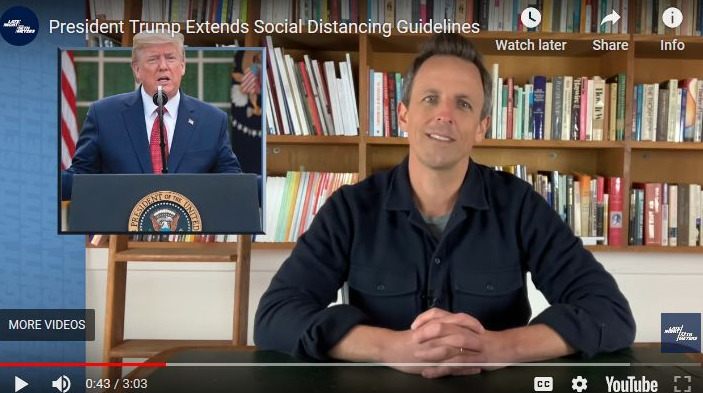When California and New York got serious about restricting non-essential gatherings, production of late night network talk shows shut down. Kimmel, Colbert, Fallon, Myers and Noah went dark, but not for long. Some of them started experimenting with at-home bits released on social media.
The shows are hugely profitable for the networks, though, so this week, Noah, Colbert et al returned to their regular time slots, but broadcasting from home. We’re used to seeing homemade video. The appeal of YouTube in the beginning was its homemade quality – shaky cameras, bad lighting, sub-optimal sound – it all gave the video an authentic feel.
The late night shows, by comparison, are slickly produced, highly processed and tightly formatted. The comedians who anchor them are finely tuned to the packaging cues — audience, band, guests — and what looks spontaneous and easy on the screen is actually the finely-honed product of years of practice and experience.
So it’s jarring to see these late night hosts, stripped of their tech armor and studio wizardry trying to tell jokes for a camera in their living rooms, basements and closets. The timing is off, the pacing is bad, the material sounds lame, and the whole thing is… awkward. Don’t take my word for it. Here’s Seth Myers’ opening monologue from Monday:
The delivery is flat, almost indifferent. Without audience reaction, he rushes, uncertain how to let the punchlines land, so he skips too early to the next joke. His timing’s off, he’s uncomfortable, and clearly not having a good time.
Then there’s Colbert:
Colbert made a career in his pre-Late Show eponymous stint on Comedy Central playing a stiff Bill O’Reilly (“Papa Bear”) figure who was willfully clueless and relentlessly out-of-touch. But he’s rarely looked so stiff and uncomfortable as he does here in his basement. Again, the joke gets told, there’s no reaction, and he’s awkwardly unsure of how quickly to jump into the next. It’s painful to watch.
These guys are pros at what they do and these stay-at-home shows presumably employ the usual clever writers. Your typical Myers and Colbert monologues when the shows are in their regular homes certainly work on the small screen as clips exported to YouTube. So why are they so cringey here? It’s not inherently the medium. YouTube is filled with comedians whose work sings in the format. Few of them have the technical resources to produce their shows that Colbert and Myers do.
Considering NBC had a couple of weeks to ready the talk shows’ new home studios, they look pretty lame, and the tech details are spotty (sound and lighting). But maybe that’s the point. Show producers know the rustic tech is considered an asset on YouTube, a sign of its authenticity. Here though, it comes across as faked authenticity and the lack of the usual slick packaging betrays the thin content. The comedians, shaken out of their usual routines, will have to relearn their timing and reimagine their audiences. Hard to imagine that the show producers, having seen these first feeble attempts, aren’t rushing to figure out how to adapt.
As are we all, having to self-isolate and move many of our day-to-day encounters online. A useful lesson, though, that even pros with ample resources have to adapt to a medium that changes the message.
Discover more from Post Alley
Subscribe to get the latest posts sent to your email.
